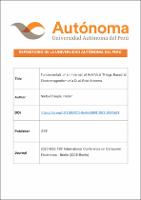| dc.contributor.author | Nieto-Chaupis, Huber | |
| dc.date.accessioned | 2024-04-04T22:20:52Z | |
| dc.date.available | 2024-04-04T22:20:52Z | |
| dc.date.issued | 2023 | |
| dc.identifier.uri | https://hdl.handle.net/20.500.13067/3080 | |
| dc.description.abstract | The arrival of a global pandemic might to detain basic human activities that to some extent would grave the social dynamics that must response as an effective manner the epidemiological crisis. In this paper a proposal of a novel Internet that aims to minimize the impact of a pandemic, is presented. Basically this technology consist in the public implementation of antenna with a dual role: detect and emit. Thus the viral load can be known at critic places of a city: bus stop, train stations, hospitals, supermarkets. By knowing the volumetric density of virus, a calibrated electric field is emitted to neutralize virus capabilities. Simulations are shown. | es_PE |
| dc.format | application/pdf | es_PE |
| dc.language.iso | eng | es_PE |
| dc.publisher | IEEE | es_PE |
| dc.rights | info:eu-repo/semantics/restrictedAccess | es_PE |
| dc.rights.uri | https://creativecommons.org/licenses/by-nc-nd/4.0/ | es_PE |
| dc.subject | Pandemics | es_PE |
| dc.subject | Wind speed | es_PE |
| dc.subject | Urban areas | es_PE |
| dc.subject | Probabilistic logic | es_PE |
| dc.subject | Internet | es_PE |
| dc.subject | Random variables | es_PE |
| dc.subject | Pattern recognition | es_PE |
| dc.title | Fundamentals of an Internet of Anti-Viral Things Based at Electromagnetism of a Dual-Role Antenna | es_PE |
| dc.type | info:eu-repo/semantics/article | es_PE |
| dc.identifier.journal | 2023 IEEE 13th International Conference on Consumer Electronics - Berlin (ICCE-Berlin) | es_PE |
| dc.identifier.doi | https://doi.org/10.1109/ICCE-Berlin58801.2023.10375629 | es_PE |
| dc.subject.ocde | https://purl.org/pe-repo/ocde/ford#2.02.04 | es_PE |


